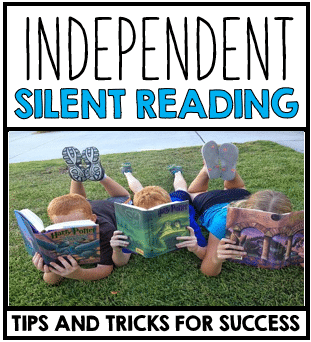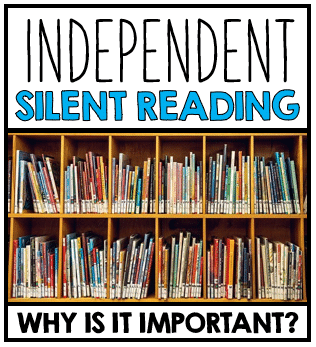Independent Reading: Tips and Tricks for Success
By MARISSA DESPINS Updated April 08, 2024
Today is my second post in my series on independent reading. In my first post, I talked all about Independent Silent Reading and why it is so important to work into your classroom schedule. Today I am going to share some tips and tricks for setting up a successful independent reading program in your own classroom.
To see all of the ready-to-teach reading resources available in my TPT shop, click on the image or button below!
Why is independent Silent reading important?
According to Pernille Ripp, founder of the Global Read Aloud and silent reading advocate,
“We’re constantly reading for skill. We’re constantly asking kids to do something with their reading, and then we wonder why they leave us and never pick up another book”
Silent reading is incredibly important. This is not just because it gets kids reading now, but because it creates readers of the future.
Silent Reading: Tips and Tricks for Success
As you can probably tell, I am a huge advocate for silent reading in my classroom. I will admit that it took a lot of trial and error for me before I turned silent reading time into something I felt was both beneficial and personally meaningful to kids. Below, I have included some of my best tips and tricks for setting up a successful silent reading program in your classroom.
Independent Reading Tip #1 – Make The Time
With all of the other things we have going on as teachers, it can be difficult to carve out an additional 10-15 minutes of class time in our already busy schedules. However, with all of the research showing how effective independent reading is in the creation of life long readers, we really do need to find a way. This reading time gives the kids the opportunity to actually apply all of the reading strategies and skills that you have been teaching them. Because of this, it is crucially important. Once you have found the time in your schedule, make sure you make the time a priority. Kids need to see that this time is valuable and important. They won’t learn this if you cancel it when “more important” things come up. Show the kids that their reading time is worthy of protection. Never sacrifice it.
Independent Reading Tip #2 – Allow for choice
As most of the reading kids do in school is assigned to them, independent reading time is the perfect opportunity to let them make their own choices about what they read. This is not the time to make kids only read books at a certain level. That is what small group reading time is for. If your struggling reader is passionate about picking up Harry Potter, even if he can only look at the pictures, let him do it! Holding a special book in your hands is a powerful feeling. It might just be the spark that ignites their reading journey.
Independent Reading Tip #3 – Allow time for discussion.
At the end of your 10-15 minute silent reading time, allow some time for class discussion. This doesn’t have to happen at the end of each silent reading time. However, it is great if you can make an effort to do this a few times a week.
This is a great time to bring the class together and show them what you have been reading. You could also use this time to introduce a new author or genre. Alternately, you can give a quick book talk on a few new titles you have picked up for your classroom bookshelf. You can have students share some of their favorite reads as well, or even have a guest staff member or parent come in and talk about one of their current favorites. Our school librarian is always game to come in and share some of her favorites. I have even had our principal come in and give a quick book talk.
These discussions can really motivate other students. I have found that kids will often choose their next reading choice based on recommendations by their peers. A new book I have shared in class rarely sits on our book shelf for long. It is amazing what a little advertising can do! Allowing time to talk about books shows kids that reading isn’t just a solitary activity.
Independent Reading Tip #4 – Celebrate Reading
Sometimes reading can get a bad rap. Kids can come into your classroom saying that they hate reading, and that it isn’t something “cool”. As a teacher of reading, it is your job to make reading cool again! Make reading in your classroom something to celebrate. Give book talks, hold mini conferences with your kids to talk about what they are reading, and get excited about new books in your classroom library. Your enthusiasm about reading really will rub off on them!
One of my favorite ways to celebrate reading in my classroom in by throwing a “book feast” at the end of the year. Have your students choose a favorite independent reading book, and bring in a themed snack to share with the class. On the day of the feast, have the kids discuss their books and the way the snack ties in. I clearly remember a group of boys one year who were hooked on the “Hunger Games” series – they brought in “Cinna”-buns (cinnamon buns), Nightlock Berries (blueberries), and Po-“Cato”-Chips (potato chips). Such a fun way to get kids excited about what they are reading, and to share that enthusiasm with others.

Independent Reading Tip #5 – Model, model, model
According to Gardiner, independent reading time “allows an adult to model the habits, choices, comments, and attitudes good readers develop“. Kids need to see that reading isn’t just something that kids are assigned to do, but something that is enjoyable to adults too. It can be very, very tempting to use this quiet classroom time to get some much needed work done, but try not to. Pick up a book, practice what you preach, and show kids you value the time as well.
For tips and tricks for keeping student accountable during reading time, check out our post on reading accountability.
Tip #6 – Let the read for readings sake
I know some of you will disagree with me on this one, and that is ok. I honestly think kids need time to just read for the singular purpose of just enjoying a good book. Put away the worksheets and reading logs, and just let them read.
Tip #7 – Provide flexible seating
Whenever possible, allow kids to sprawl out and really get comfortable with their books. Bring is comfy cushions, exercise balls, or anything else you can get your hands on to facilitate this. If it is a nice day, and your administration is on board, you can even take them outside to lay in the grass. In the past I have been known to bring in a class set of yoga mats, move the desks out of the way, and let the kids lay out on the floor. While I haven’t let the kids set up blanket forts just yet, I wouldn’t be opposed to the idea!

I certainly wouldn’t argue about the importance of many of the things we do in our classrooms on a regular basis – in depth novel studies, writing instruction, and group work are all essential parts of the language arts classroom. Clearly, however, we can see the importance of getting books into our students hands, and for allowing them to read independently during the school day. No matter what instructional methods we choose to use, our students need time to actually apply the reading strategies and skills we teach if we want them to become skilled readers. To do this, our kids need time to read! Silent reading time is really just another tool in our arsenal for developing life long readers, who thoroughly enjoy the reading process.
Are you an advocate for Independent Silent Reading? How are you best able to work it into your schedule? Pleas let me know in the comments below!
For additional reading information that you can apply to your own classroom, check out our complete reading strategy guide!
Interested in checking out my previous post on Silent Reading?
Click on the link below!
Independent Silent Reading: Why is it important?
Interested in signing up for my email list?
If you are interested in signing up for my email list, you can do so by clicking on the link below. I periodically send out emails with free resources, teaching tips, and exclusive deals. Signing up will also give you immediate access to some of my best selling Interactive Notebook resources – foldables, graphic organizers, and other fun activities.







